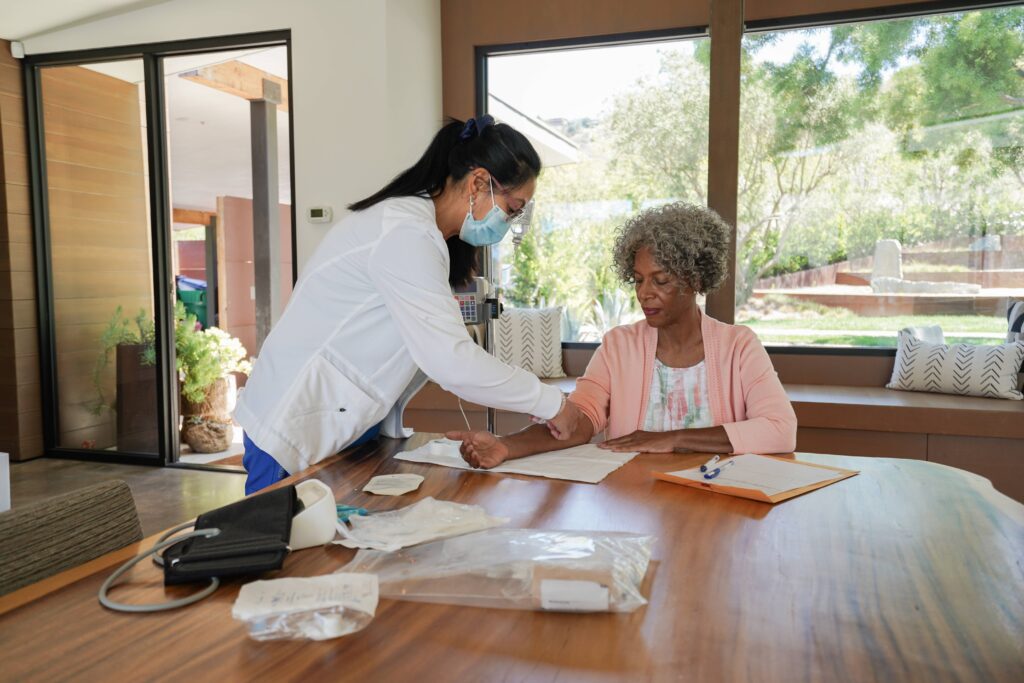
Immune cells produce antibodies, specialized proteins that aid in the neutralization and removal of foreign pathogens. Antibodies are also referred to as immunoglobulins (Ig). Immunoglobulins are specialized to bind to very particular regions of other cells, acting like a lock and key. Immunoglobulins constantly circulate in the bloodstream, searching for foreign cells to bind to. Immunoglobulins can be extracted from healthy blood donors during blood donations, separated from other blood components, and administered intravenously to a patient in need. This treatment is known as intravenous immunoglobulin (IVIG). IVIG has been an FDA-approved treatment for various medical conditions for several years. However, just as with any other medical treatment, there is a risk of side effects with IVIG treatment. Many of these adverse effects are mild and treatable, but it is important to be aware of IVIG therapy’s side effects before starting treatment.
Ask About IVIG Home Infusion
How IVIG Is Produced
IVIG is produced from the pooled blood donations of thousands of people, all of whom have been screened. There are five different types of immunoglobulins in the body. IVIG consists mainly of one specific immunoglobulin, IgG. It takes approximately nine months to process the immunoglobulins to isolate IgG and prepare it for transfusion. The purification process is essential to minimize the side effects of IVIG treatment. For example, another type of immunoglobulin, IgA, can cause allergic reactions and, therefore, is removed from the pool. The process also aims to remove stabilizers and preservatives that may contribute to IVIG therapy’s side effects. IVIG goes through extensive treatment to inactivate pathogens like HIV and the hepatitis B and C viruses. Nanofiltration, low pH treatment, heat treatment, and other procedures are among the steps. Due to the immune function that immunoglobulins naturally possess, this also lowers the possibility that any contagious viruses will survive the production process and reach recipients.
How IVIG Works
Knowing how IVIG works can help you understand the side effects of IVIG treatment. One of the primary uses of IVIG is to offer protection to immunosuppressed individuals from infection. IVIG may also be used in autoimmune conditions, where the immune system mistakenly attacks the body’s own cells. Side effects of IVIG therapy are more common in people with multiple medical conditions. Immunoglobulins have automated immune effects that do not require active immune cell replication. Therefore, they can be given intravenously to someone whose immune system is suppressed, such as in hypogammaglobulinemia or IgG deficiency, to protect them from infection. However, this sudden activation of immune effects in IVIG treatment can cause side effects such as muscle aches and chills. IVIG also has anti-inflammatory and immune-regulating properties. The immunoglobulins may help prevent the maturation of other immune cells or interfere with signals that promote immune effects, helping calm the immune system and minimize the damage it causes in autoimmune conditions such as Guillain-Barré syndrome or chronic inflammatory demyelinating polyneuropathy.
How IVIG Is Dosed and Administered

The dosing for IVIG is variable and depends on the condition it is being used to treat. While the dose differs between conditions, it is always based on weight. Side effects with IVIG treatment are more likely with larger doses. If someone experiences significant side effects with IVIG therapy, smaller doses may be used in subsequent treatments. Adverse effects are also more likely with faster infusion rates. Simply slowing the infusion rate can be effective at reducing the risk or severity of side effects. IVIG is also kept at cold temperatures to extend its shelf life. It is allowed to warm up to room temperature before infusion to help reduce side effects. The first infusion is typically administered in a healthcare facility with experienced medical professionals available to treat any side effects of IVIG treatment. However, it is possible to have IVIG infusions at home with a specialized infusion nurse. Immunoglobulins typically remain in the body for two to six weeks, though this varies depending on the condition and individual.
Get IVIG Copay Assistance
IVIG Financial AssistanceMild Side Effects of IVIG Therapy
The majority of IVIG side effects start to manifest shortly after the infusion begins. Tylenol and nonsteroidal anti-inflammatory drugs (NSAIDs) like Motrin or Benadryl can be used to treat the majority of reactions quickly because they are mild, transient, and treatable. Sometimes, simply stopping the infusion and allowing symptoms to resolve before starting again is sufficient. People are more likely to experience symptoms with their first treatment. The most common side effect of IVIG treatment is headache. But chills, flushing, fatigue, muscle aches, and abdominal pain may also occur. These symptoms may be a side effect of the infusion. But they could also be due to an underlying infection that causes the transfused immunoglobulins to activate the immune system and release signals that cause the typical flu-like symptoms. Treatment may be stopped if symptoms appear in order to check for hidden infections, which are most frequently found in the sinuses and lungs. Otherwise, only treating the symptoms is required.
Severe Side Effects of IVIG Treatment
While there is a potential for severe side effects to IVIG therapy, they are exceedingly rare. Similar to the mild side effects, the more dangerous reactions typically appear immediately or within a few hours after starting treatment. These side effects are also more likely to manifest during the initial treatment or following a change in IVIG product. One such reaction that may occur after receiving IVIG therapy is anaphylaxis. Anaphylaxis is a serious allergic reaction that can result in swelling of the airways, hives, vomiting, low blood pressure, and even death. This is most commonly due to IgA deficiency and can be treated by stopping the infusion and administering epinephrine. Anaphylaxis with IVIG is now extremely uncommon due to recent improvements in the manufacturing process. Other possible but rare side effects of IVIG treatment include transfusion-associated circulatory overload (TACO) and transfusion-associated lung injury (TRALI). Respiratory distress can result from either condition. Slowing the infusion, using less salty solutions, and adding diuretics to help the patient urinate extra fluid are all possible treatments for TACO. TRALI is treated by abruptly stopping the infusion and providing respiratory support.
Long-Term Side Effects of IVIG Therapy
IVIG may be associated with some long-term or delayed effects after treatment. IVIG recipients might have a higher risk of developing blood clots. Blood clot risk is higher in people with other conditions like cancer, estrogen therapy, immobilization, and some hereditary connective tissue diseases that increase their risk of clot formation. Although rare, another possible side effect of repeated IVIG treatment is kidney injury. Individuals in the geriatric population, those aged 65 and up, as well as those with pre-existing renal conditions, are at a higher risk. This heightened susceptibility may be attributed to the presence of sugars within (IVIG) treatments or the release of toxic remnants from red blood cells that are destroyed upon interaction with transfused immunoglobulins. Anemia can occasionally result from IVIG when enough red blood cells are destroyed. For these reasons, if the recipient exhibits symptoms like pallor, fatigue, or weakness, testing for anemia may be carried out for a few days after transfusion. Several days after IVIG treatment, eczematous reactions may also occur as a side effect.
Vaccine Scheduling with IVIG

Decreased immune response to live vaccinations is a known side effect of IVIG therapy. A virus that can replicate in the body and trigger an immune response but is too weak to infect the body is introduced through live vaccines. Immunoglobulins that have been transfused may stop the virus from replicating, preventing the body from mounting a sufficient immune response. In order to ensure a sufficient immune response and adequate protection, live vaccinations should not be given immediately after IVIG therapy. Vaccination schedules vary, but typically there is a gap of several months between vaccinations.
Treatment Info
Get IVIG Prior AuthorizationHow to Minimize the Side Effects of IVIG Treatment
One of the simplest ways to minimize the risk of side effects with IVIG therapy is to adequately hydrate prior to beginning treatment. This can be achieved by drinking plenty of fluids in the days leading up to your IVIG infusion. Premedication is typically not necessary, but those who have a history of headaches may do so by taking an NSAID or Tylenol. Tylenol or Benadryl premedication may also be helpful for people who have previously experienced itching, nausea, chills, or muscle aches after receiving IVIG. However, these symptoms often subside on their own with time. It’s significant to note that different IVIG manufacturers may prepare infusions using different techniques. Sometimes, switching to a different IVIG product may help prevent recurrences of side effects with IVIG treatment. It is not advised to change to a different product if a patient has previously received and tolerated an IVIG product from a particular brand.
Receive IVIG at Home with AmeriPharma™ Specialty
If you need IVIG treatment, AmeriPharma™ Specialty can help. We hold a specialty pharmacy license in more than 40 US states and territories and are URAC and ACHC accredited. With more than 20 years of experience administering IVIG infusions, we have the expertise needed to minimize IVIG therapy’s side effects. For the administration of your treatment, we’ll send a trained infusion nurse to your home. At AmeriPharma™ Specialty Pharmacy, we strive to reduce the burden of your treatment. We not only administer home infusions, but also help with insurance approvals and copay assistance to reduce the cost of your therapy. Reach out to us at (877) 778-0318 to discuss treatment with a patient advocate or talk with a licensed pharmacist. AmeriPharma™ Specialty can assist you right away.













